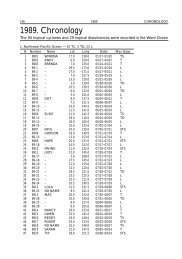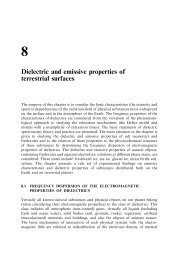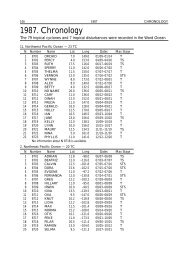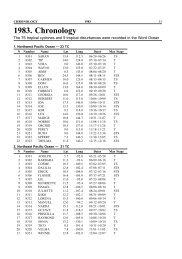Программа и тезисы докладов - Институт космических ...
Программа и тезисы докладов - Институт космических ...
Программа и тезисы докладов - Институт космических ...
You also want an ePaper? Increase the reach of your titles
YUMPU automatically turns print PDFs into web optimized ePapers that Google loves.
The STrong elF/vlF eMiSSionS aSSociaTed WiTh The ThunderSTorM<br />
over SouThern France on ocTober 8, 2009<br />
J. Błęcki 1 , M. Parrot 2 , R. Wronowski 1<br />
1 Space Research Centre PAS, Warsaw, Poland<br />
2 LPCE/CNRS, Orleans, France<br />
We will report the observation of ELF and VLF emissions recorded on the low<br />
altitude satellite DEMETER during strong thunderstorm activity. At an altitude of<br />
~650 km, waves observed on the E-field spectrograms at mid-to-low latitudes during<br />
night time are mainly dominated by up-going 0+ whistlers but associated with<br />
electron whistlers. During the night of October 8, 2009 the strong thunderstorm<br />
activity occurred in the vicinity of Castres. ELF and VLF data have been recorded<br />
by the satellite just over the Castres region during this strong thunderstorm activity.<br />
In this time the DEMETER instruments were switched in the burst mode and it<br />
was possible to register the wave forms. It is shown that the strongest emissions have<br />
been triggered by two intense –CG lightning strokes (–118 and –155 kA) separated<br />
by 2 seconds. It is shown that the whistler wave propagates from the thunderstorm<br />
regions in the Earth-ionosphere guide and enters in the ionosphere below the satellite.<br />
They last several tens of milliseconds and the intensity of the ELF waveform is<br />
close to 3 mV/m. A particularly intense proton whistler is also associated with these<br />
emissions. The variations of the electron temperature was seen during this event.<br />
FracTal elecTrodynaMicS oF a ThunderSTorM cloud<br />
D. I. Iudin 1,2 , A. A. Emelyanov 2 , V. Y. Klimashev 2 , R. D. Dmitrenko 2<br />
1<br />
Institute of Applied Physics of RAS, Nizhnii Novgorod, Russia<br />
2<br />
Scientific Research Institute of Radio Physics, Nizhnii Novgorod, Russia<br />
Despite the huge volume of investigations concerning physics of thunders,<br />
there are still many gaps in our understanding of the physical processes of gas<br />
clouds electric structure formation, the initiation of lightning breakdown and lightning<br />
propagation, the generation of new chemical compounds and the role of thunder<br />
generators in the global electric circuit. The complexity of the problem is accounted<br />
for by the scale of the very phenomenon: the value of physical parameters,<br />
relating to lightning and thunderstorm, evolve by 15 magnitude orders of atomic<br />
distances, which characterize the process of thunder cloud electrification of tens<br />
and hundreds of kilometers, covering the air motion within the whole thunderstorm<br />
system.<br />
On the one hand, the indicated scale of the phenomenon reflects its complexity,<br />
and on the other hand it serves as a key to their basic regularity understanding.<br />
The point is that the wide scale range of thunderstorm electricity frequently takes<br />
the form of scaling, when in the wide range of space and time intervals the phenomenon<br />
is characterized by self-similarity.<br />
In terms of the quality the thunder cloud dynamics appears to be a self-organized<br />
and self-adjusting critical mode. Phenomena of this kind were by brought<br />
together by the general term “systems with self-organized criticality”. In the mode<br />
37

















